There are two versions of the Wilderness version of two Subaru models – the Forester and the Outback.
Each are similar in that they both come standard with additional features that make them more capable of operating in rough conditions – both on and off-road – than the other versions of these models. These upgrades include a raised suspension and more ground clearance as well as water-wicking interior materials, skid plates and a higher maximum tow-rating (3,500 lbs.)
But there are also a number of important distinctions that make each of them each very different things, too. 
What It Is
The Outback is a wagon version of Subaru’s mid-sized Legacy sedan – which is no longer sold as a wagon, interestingly enough.
In addition to being a wagon – with more room for cargo – the Outback also comes with more ground clearance (8.7 inches vs. 5.9) than the Legacy, which is now a sedan-only.
The Wilderness version of the Outback wagon comes with the most clearance – 9.5 inches – as well as a different version of Subaru’s all-wheel-drive system that features a low-ratio crawl mode for additional leverage in rough conditions, an upgraded roof rack that can handle heavier loads and unique-to-this-trim exterior and interior trim.
The Wilderness version of the Forester is almost identically equipped but is very different in that it isn’t a wagon – and doesn’t offer the much stronger turbocharged version of the 2.4 liter four cylinder engine that comes standard in the Wilderness version of the Outback.
No surprise, the latter costs more, too – $37,695 (for the Outback Wilderness) vs. $33,520 for the similar thing in a Forester-shaped package.
You pay more – or less – to get more (or less).
What’s New
The Wilderness package is new – for both of these Soobies.
The same additional capability as found in the Wilderness version of the Forester.
More engine – more power – is standard in the Wilderness version of the Outback – and not available in the Wilderness version of the Forester.
A wagon version of the Wilderness – for those who don’t want another crossover.
What’s Not So Good
Wagon version of the Wilderness costs about $4k more than the crossover Forester version.
No option to skip the more powerful turbo engine in favor of the less powerful but less costly non-turbocharged engine you can get in other Outbacks (and that’s standard in the Wilderness version of the Forester).
A bit less vertical space in the wagon.
Most Outbacks come standard with the same 2.5 liter, four cylinder boxer engine that’s standard in the Wilderness version of the Forester. It makes 182 horsepower and 176 ft.-lbs. of torque. The Wilderness version of the Outback comes standard with a smaller, 2.4 liter engine that’s turbo-boosted to make 260 horsepower and 277 ft.-lbs. of torque.
This engine is not available in the Wilderness version of the Forester – which brings up some important, related, differences.
First is cost, as mentioned earlier. The Wilderness version of the Outback is a considerably more expensive elaboration of the Wilderness concept. But you do get what you pay for, in terms of the additional power – and the additional acceleration.
The Forester Wilderness takes about 8 seconds to get to 60 MPH; the Outback Wilderness can make the same run in 5.8 seconds, which is no small difference. 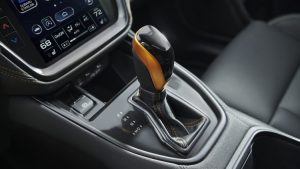
There’s another difference – between the Wilderness version of the Outback and the standard-issue Outback, equipped with the same 2.5 liter engine that’s standard in the Wilderness version of the Forester.
It rates 26 city/33 highway – in the standard Outback – which works out to an astounding highway range of 610 miles on 18.5 gallons gas in the tank. Even in city driving, the regular Outback can go 481 miles in between fill-ups.
But not so far – literally – when the Outback is ordered in Wilderness form, with the standard 2.4 liter turbo’d engine. Mileage drops to 22 city, 26 highway and along with it, the distance you can travel to the wilderness before you’ll need to stop – for a fill-up. Highway range goes down to 481 miles – curiously/coincidentally the same as the city mileage of the Outback with the 2.5 liter engine. In city driving, the difference between the two isn’t as pronounced.
The Wilderness can go 407 miles vs. 481 for the standard Outback.
What’s also interesting is how far you might have been able to go in the Wilderness version of the Forester, which has the same high-mileage engine as the standard versions of the Outback – but lacks the same-sized gas tank. The Forester’s holds about two gallons less (16.6 gallon) so you can do the math.
With another two gallons of fuel on board, the Forester Wilderness could probably travel 500-plus miles on a tankful. 
Either way, both of these Soobies go much farther than any electric car, without any asterisks, either.
An EV’s touted maximum range is dependent on various factors such as heat and cold that have almost no effect on non-electric cars. An EV that touts its ability to travel say 300 miles may only travel 200 – or less – in the very cold or the very hot. This reduction in range is then compounded by the length of recharge time – and by the fact that if you try to cut that time down via “fast” charging the EV, you can only partially recharge the EV (to about 80 percent) on that time – and thus have even less range than advertised when you resume driving.
Which means more time spent recharging, again. 
One thing that’s the same as regards these two Soobies is that both the 2.5 liter and 2.4 liter engines are regular fuel engines – even thought the 2.4 liter engine is turbocharged, which often necessitates the use of premium fuel to make the advertised power (and deliver on the advertised mileage). This is an important sameness given the price of premium fuel – which is even more extortionately expensive than regular all-of-a-sudden, courtesy of the Biden Thing.
As is the case in almost all new Subarus – and every Outback and Forester, Wilderness and not – a continuously variable (CVT) automatic is standard. But only the Wilderness versions of these Soobies have a low-range reduction feature, for increased leverage at slow speeds. They also have nearly 10 inches of ground clearance, increasing their ability to deal with heavy, unplowed snow and uneven terrain, such as washed out gravel roads.
And they are rated to pull more than other versions of the same thing – 3,500 vs. 2,700 lbs. for the Outback Wilderness.
Subaru’s “symmetric” all-wheel-drive is also standard – so called because it is symmetrical, in conjunction with the boxer engine, which is half on one side of the centerline of the car (front to back) and half on the other. Subaru says this gives its cars inherently better balance, enhanced by the fact that the engine is also flat rather than standing upright, thereby lowering the center of gravity.
Power is the difference, here.
The Wilderness version of the Outback has the heart of a WRX – the high-performance AWD sport sedan that’s the street-legal version of Subaru’s regularly successful World Rally Cup race cars. Both have the same turbo’d 2.4 liter engine and so performance is very similar.
But capability is very different.
The WRX has about half the ground clearance (5.4 inches) and doesn’t have knobby, all-terrain tires that are standard features of the Outback Wilderness. It is a fine machine to drift in – but drifts are not its thing.
The Outback can sidle across creeks a half-a-foot-deep. Do not try this in a WRX.
The Outback Wilderness can also pick its way over ruts-growing-into-small-canyons on washed-out dirt/gravel roads that would dent the floorpans of the WRX and possibly leave it hanging, wheels spinning.
The extra level of capability added to the level of performance/acceleration that comes with the same basic engine as the WRX has under its hood makes for a vehicle that is more versatile and even more fun that the WRX, because of the places you can take the Wilderness that you can’t get to in a WRX.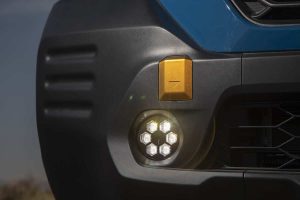
There is also another thing – which I got into in my review (here) of the Wilderness version of the Forester – that likewise applies to the Wilderness version of the Outback and is a huge contrast vs. the WRX. This thing is the Outback’s ride – which is remarkably and happily cushy – to a great extent because of those fat-sidewall tires it wears. These have give – which is what you want when picking your way over rocks and ruts on a “road” fit for dirt bikes more so than cars. They also give you a softer ride than you typically get with the inch-high-sidewall “sport” tires that modern sport sedans/performance cars wear. These do sharpen up steering feel, a desirable attribute in a performance car. But they also sharpen up the ride, which can get old after awhile.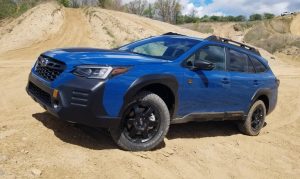
The Wilderness – either one – is one of the most comfortable new cars you’ll find, both on and off-road. Some will also like the easier (because higher up) getting in – and out – afforded by the Outback Wildernesses lifted stance.
As well as being higher up, once you’re inside.
At The Curb
There is another, more practical aspect of this lifted, wagonized WRX. Especially in view of the fact that the WRX is no longer available in wagon/hatchback form. Like the Legacy, the WRX is a sedan only now – with a very small (12.5 cubic feet) trunk. The Outback Wilderness – being a wagon – has more than twice as much space for your stuff behind its second row (32.5 cubic feet) and more than five times as much (75.7 cubic feet) if you fold down the second row.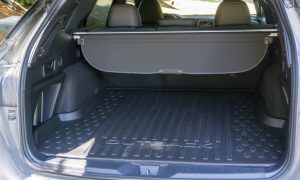
This is about the same overall space as in the Wilderness version of the Forester – which is a crossover – but the Forester version’s space is more vertical, due to its taller/boxier design. This gives it a bit of an edge over the wagon version of the Wilderness – in terms of it being a little easier to squeeze/stack/carry taller items in its cargo area. But it’s not a big difference while there is a lot of visual difference between a wagon and a crossover. Neither is necessarily better – or worse – than the other in a functional sense. The point of difference is the being different-looking.
Some will simply prefer the look of the wagon over the look of the crossover.
Both do share a common aesthetic – in terms of the distinctive paint schemes, offset by a matte-black hood decal and contrast-color/anodized trim pieces inside and out. And they each come standard with a stronger roof rack that can handle up to 700 pounds of load as well as seats covered in a water-wicking simulated leather material that can easily be wiped down if you get them muddy and won’t get moldy if you get them wet.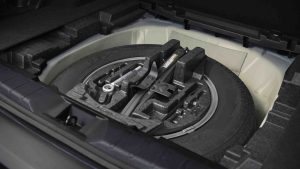
The Wilderness also comes standard with most of the extras that come in the Premium trim, including the larger (11.6 inch) LCD touchscreen in the center stack, heated (and folding) outside rearview mirrors and heated seats.
One thing you don’t get – unless you pay $292 extra for it – is a wireless phone charger. An interesting – because it’s so rare – option is the CD player that can be aded for $399.
Another thing you get – and it’s standard – is a spare tire. A real, full-size spare – with the same tire as the other four. Not a “mini” spare that lets you gimp to the next service station – which may be far from the wilderness you’re in. 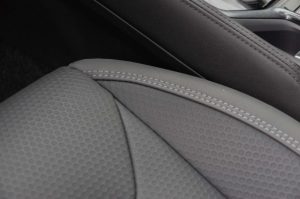
The Rest
It’s handy that Subaru offers the Wilderness in two distinctly different permutations. On account of that, you can buy the version whose looks, performance – or price – you prefer. That said, it might be nice if Subaru offered the choice of either engine in both of these rigs, so that the people who prefer the wagon layout – and look – but who don’t need the additional power of the turbocharged 2.4 liter engine but would very much like a lower price tag and much longer range/better gas mileage – could choose to go with the more economical and less-costly 2.5 liter engine.
And, the reverse. That people who prefer the looks and layout of the crossover could opt for the more powerful 2.4 liter engine.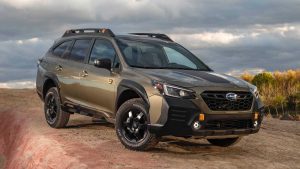
A manual transmission would also be nice – as it would add fun as well as frugality to the mix. Manuals give you more control over the vehicle and they cost less than automatics. Especially down the road. A manual-equipped vehicle will need a new clutch, eventually – but the transmission, itself, will likely never fail unless you own the car for 20-plus years. Automatics often are shorter-lived and when they fail, their cost to replace is often more than the car is worth by then.
The Bottom Line
More choice is always a good thing – even if it’s not all in the same package.
. . .
Got a question about cars, bikes or anything else? Click on the “ask Eric” link and send ’em in! Or email me directly at [email protected] if the @!** “ask Eric” button doesn’t work!
If you like what you’ve found here please consider supporting EPautos.
We depend on you to keep the wheels turning!
Our donate button is here.
If you prefer not to use PayPal, our mailing address is:
EPautos
721 Hummingbird Lane SE
Copper Hill, VA 24079
PS: Get an EPautos magnet or sticker or coaster in return for a $20 or more one-time donation or a $10 or more monthly recurring donation. (Please be sure to tell us you want a magnet or sticker or coaster – and also, provide an address, so we know where to mail the thing!)
My eBook about car buying (new and used) is also available for your favorite price – free! Click here. If that fails, email me at [email protected] and I will send you a copy directly!




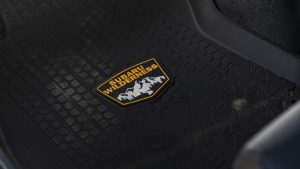
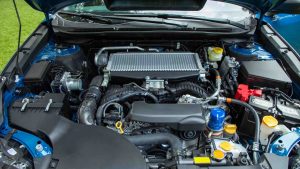
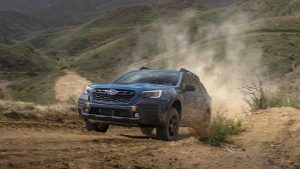
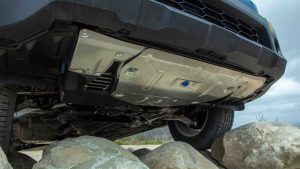








As an owner of a 2015 2.5 prem Outback, the Wilderness OB puts a odd smile on my face. Entry point for my OB in ‘15, was low-mid $20’s. I just replaced the suspension w new Bilsteins, King springs and a lift kit. All this for a fraction of the MSRP of these new Wilderness models. If I want to tow, I ask the Mrs. for the keys to the Gen2 TDI VW Treg. (7700 #’s) I get that Subaru wants ‘wallet share’ of the $50k auto market, I’m just not that buyer. Heading off the the big box store to get some bright orange duct tape to complete the mods on my OB; oh, and maybe some Plasti dip for the hood. 🥲🥲
Hi Gen,
O agree with you. I much-like these new Wilderness iterations of the Outback and Forester. I do not like the MSRP. But Subaru isn’t all to blame for this. There’s inflation – and there’s government, the latter being the chief driver (up) of new car prices. Take away the compliance costs and – even with its suite of extra equipment, A Forester Wilderness could probably be offered (at a decent profit) for around $28k.
It wasn’t until I found myself behind the wheel of a 2022 Subaru Outback Wilderness that I realized just how many Subarus there are out there. At every stoplight, at every corner, at every drive-thru, at the school pick-up line, they’re everywhere. On one day I must’ve counted at least a dozen during my usual, twice-a-day school runs. To me, Subarus had always been overly rugged-looking wagons with loyal followings, but I never really understood what made people flock to them over Toyotas or Hondas. https://uniweey.com/
One of my children drives an older Outback, they are really good cars. Rented a 2014 Subaru Outback eight years ago now, a great car to drive.
While driving down a two-lane highway, an oncoming vehicle pulling a trailer threw a rock straight at the windshield, the pebble was about an inch or so in size, hit the windshield at eye level, driver’s side. It was flat and the rain probably skipped it rather than the rock impacting the windshield. Got lucky.
For every one million barrels of oil stolen from Mother Earth by the dirty oil companies, there are some 650,000 barrels of produced water from wells. The production water gets pumped back into the ground in old wells gone dry, plugged and abandoned. The water has caused a problem in Texas, some of the production water has migrated to an old well that was abandoned and forgotten, the production water now is gushing from the old well casing and forming a geyser of brine water 100 feet into the air. Water has to go somewhere. Hauling production water from oil well sites is a big job too.
https://www.texasmonthly.com/news-politics/west-texas-geyser-oil-well-chevron/
A cool photo, though. Texas has 1.1 million oil and gas wells, bound to be a problem now and then.
Another day on the planet, 1.2 billion ICE machines doing the same thing all over again today.
All to see the Pyramids along the Nile.
If only the 3.6L six were still available…
Hi Bryce,
I took some friends out for a drive in the Outback and they said the same. I’ll say the same, now. I’d much rather have the 3.6 naturally aspirated than the turbo four. But we know why we can’t have that…
Could be made to work as an off -road vehicle, but open the wallet.
Hi Manse,
Amen. I’d love for Subaru to return to its roots and offer up something like this but less pricey. There is no reason – well, other than government and the rip-tide effect of the general public’s comfort with debt – that a wagon like this could not be built and sold for around $20k rather than $30k-plus. Indeed, VW has built one that’s along these lines – the Taos. It’s not lifted and it hasn’t got some of the Soobie’s other gear – but these could be added without adding another $10k to its low $20k price tag.
Subaru also sells the Crosstrek – and I’m hopeful a Wilderness version will be forthcoming – and around $26k or so.
Still ugly.
Still CVT only.
I have a 2016 ugly Outback with 3.6L engine and CVT. It’s one of the best cars I’ve ever owned. Visibility is really good compared to other cars, it can’t be stopped in snow, and I routinely go around SUV’s that are stuck. The CVT feels like a mediocre automatic transmission, but it’s not awful, just emits a whining sound when handling a lot of torque.